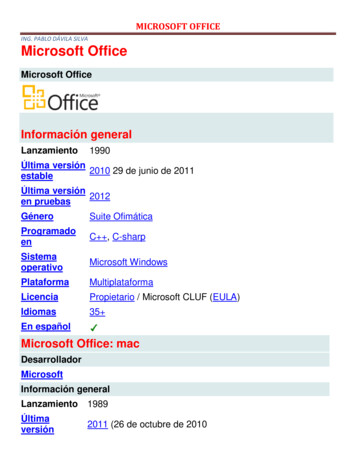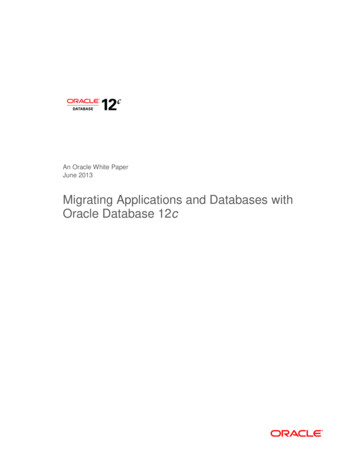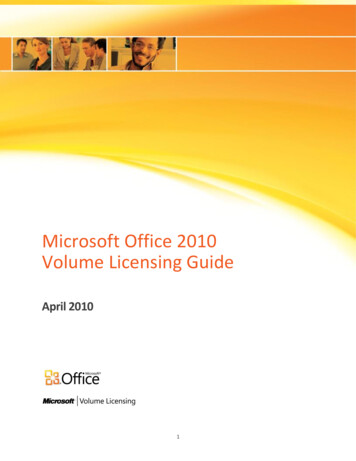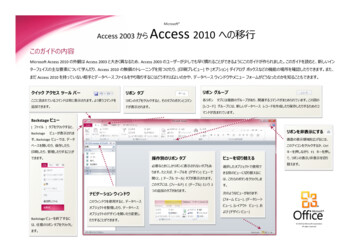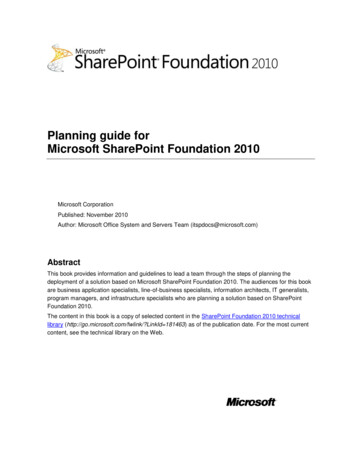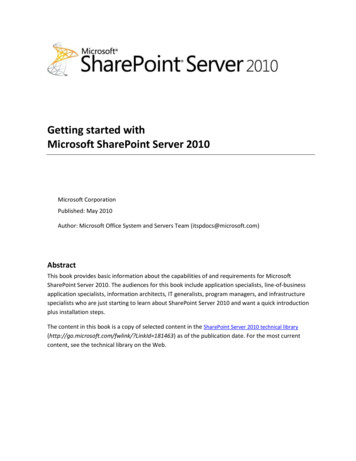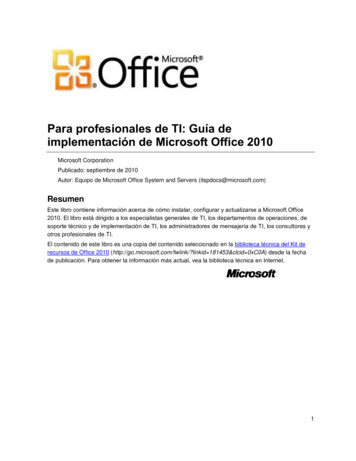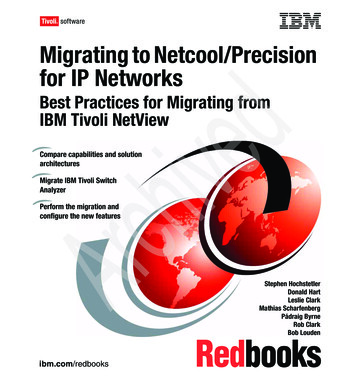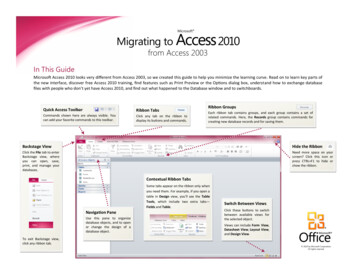
Transcription
Migrating to Access 2010Microsoft from Access 2003In This GuideMicrosoft Access 2010 looks very different from Access 2003, so we created this guide to help you minimize the learning curve. Read on to learn key parts ofthe new interface, discover free Access 2010 training, find features such as Print Preview or the Options dialog box, understand how to exchange databasefiles with people who don’t yet have Access 2010, and find out what happened to the Database window and to switchboards.Quick Access ToolbarRibbon TabsCommands shown here are always visible. Youcan add your favorite commands to this toolbar.Click any tab on the ribbon todisplay its buttons and commands.Ribbon GroupsEach ribbon tab contains groups, and each group contains a set ofrelated commands. Here, the Records group contains commands forcreating new database records and for saving them.Backstage ViewHide the RibbonClick the File tab to enterBackstage view, whereyou can open, save,print, and manage yourdatabases.Need more space on yourscreen? Click this icon orpress CTRL F1 to hide orshow the ribbon.Contextual Ribbon TabsSome tabs appear on the ribbon only whenyou need them. For example, if you open atable in Design view, you’ll see the TableTools, which include two extra tabs—Fields and Table.Navigation PaneUse this pane to organizedatabase objects, and to openor change the design of adatabase object.To exit Backstage view,click any ribbon tab.Switch Between ViewsClick these buttons to switchbetween available views forthe selected object.Views can include Form View,Datasheet View, Layout View,and Design View. 2010 by Microsoft Corporation.All rights reserved.
Migrating to Access 2010Microsoft from Access 2003How to get started with Access 2010Where are my menus and toolbars?Access 2010 opens in Backstage view, which contains many of thecommands that were on the File menu in Access 2003.In Access 2010, a wide band spans the top of the main programwindow. This is the ribbon, and it replaces the old menus and toolbars.Each tab on the ribbon has different buttons and commands that areorganized into ribbon groups.In Backstage view, you can create and save new databases, start from atemplate, open existing databases, and publish them to SharePoint.You can also get help in Backstage view. We have many free resourcesavailable to help you learn Access 2010, including training courses and amenu-to-ribbon guide that lets you click any Access 2003 command, andthen shows you exactly where that command is located in Access 2010.When you open a database, the ribbon’s Home tab is displayed. This tabcontains many of the most frequently used commands in Access. Forexample, the first thing you’ll see on the left side of the tab is the Viewsgroup, which can include the Form View, Datasheet View, Layout View,and Design View commands.Next, in the Clipboard group, you’ll find commands to paste, cut, andcopy, as well as the Format Painter.To find these free resources, click the File tab, and then click Help. Then,under Support, click Getting Started.The ribbon adjusts its appearance to fit your computer’s screen size andresolution. On smaller screens, some ribbon groups may display only theirgroup name, not their commands. In that case, simply click the smallarrow on the group button to reveal the commands.
Migrating to Access 2010Microsoft from Access 2003What happened to the Database window?When you open a database or create anew one in Access 2010, the names ofyour database objects appear in theNavigation Pane, which replaces theDatabase window that was inAccess 2003.The database objects include yourtables, queries, forms, reports, pages,macros, and modules. The NavigationPane divides your database objectsinto categories, and those categoriescontain groups. Some categories arepredefined for you, and you can alsocreate your own custom groups.What happened to switchboards?Switchboards are Access forms that contain buttons or hyperlinks that,for example, open a form or a report. Using a switchboard is a way ofhiding database objects that you do not want other users to see.In Access 2010, you can use the Navigation Pane in place of switchboards.To do so, you create custom categories and groups that provide shortcutsto only the objects that you want users to see. Then, you set options forthe Navigation Pane so that remaining objects are hidden. Right-click thetop of the Navigation Pane, and then click Navigation Options.If you used the Database window toperform a task with a databaseobject in Access 2003, you nowperform that task by using the Navigation Pane. To open or apply acommand to a database object, right-click the object and select a menuitem from the list.In the Navigation Pane, the list of objects is always visible; things don’tget buried under forms and other objects. You can also search for objectsin this pane.To add a custom category, click Add Item. To add a custom group, selecta custom category, and then click Add Group. You can hide a group byclearing its check box. After you create your custom groups, add objectsto them by dragging them in the Navigation Pane. To hide a databaseobject, add it to a hidden group.
Migrating to Access 2010Microsoft from Access 2003Things you might be looking forLook over the table below to find some of the common and familiar things that you might be looking for in Access 2010. Although this list isn’tcomprehensive, it’s a good place to start. For a full list of Access 2010 commands, click the File tab, click Help, and then click Getting Started.To.Rearrange items in the Navigation PaneCreate new tables, forms, and other objectsDo this Right-click the top of theNavigation PaneClick theCreate tabAnd then.Select the organization options you want,such as Sort By or View ByClick the command for the object you want to createView and edit database relationshipsClick theDatabase Tools tabIn the Relationships group, click RelationshipsSplit a database into front-end and back-end databasesClick theDatabase Tools tabIn the Move Data group, click Access DatabaseSave a database as a different version Access databaseClick theFile tabImport or export dataEncrypt a databaseClick theExternal Data tabClick theFile tabClick Save & Publish, and then, under Save Database As,click the format you wantSelect the data format from which you want to import,or to which you want to exportClick Encrypt with Password
Migrating to Access 2010Microsoft from Access 2003Where is Print Preview?What happened to Tools Options?In Access 2010, look for Print Preview in Backstage view, alongside otheruseful print-related settings.Looking for the program settings that let you control things like selectinga default form for the current database? Or perhaps you’d like toconfigure the database so that objects are displayed in overlappingwindows instead of on document tabs.Click the File tab, click Print, and then click Print Preview. The PrintPreview tab opens with a preview of how the current object will lookwhen printed.You can use the options on the Print Preview tab to fine-tune yourpreferences, for example, to change the paper size, set margins, or tochange the orientation from portrait to landscape. You can also exportthe object’s data in a variety of formats by using the commands in theData group. When you’re ready to print, click Print at the far left of thePrint Preview tab.Click the File tab, and then click Options. This opens the AccessOptions dialog box, where you can customize your Access settings andpreferences.Some settings in the Access Options dialog box apply only to Access. Butsome preferences (for example, the color scheme) will apply to all otherMicrosoft Office 2010 programs that you have installed.
Migrating to Access 2010Microsoft from Access 2003Keep your favorite commands nearbyCreate ribbon tabs or groups of your ownThe Quick Access Toolbar in the upperleft corner of the Access program windowprovides shortcuts to commands you’lluse often.You can customize ribbon commands byputting buttons into ribbon groups whereyou want them to appear, or by creatingcustom ribbon tabs of your own.By adding buttons to this toolbar, you cankeep all of your favorite commands visibleat all times, even when you switch ribbontabs.Right-click any ribbon group and then clickCustomize the Ribbon. In the Access Options dialog box, you can add commands toyour own tabs or groups. For example, youcould create a tab called Controls, and thenadd some of your most frequently usedcommands to a custom group on this tab.Click the drop-down arrow next to the Quick Access Toolbar to turn on oroff any of the commands in the list. If the command you want to add isn’tshown in the list, switch to the ribbon tab where the button appears andthen right-click it there. On the menu that appears, click Add to QuickAccess Toolbar.If you make a mistake, don’t panic. You canuse the Reset button if you want to go backto the default (“factory”) settings.Not all older Access commands appear on the ribbon, but most are stillavailable. If you can’t live without some of these, simply add them to theribbon or to the Quick Access Toolbar.In the Access Options dialog box, in the Choose commands from list,select Commands Not in the Ribbon. Next, find the command that youwant and add it to a custom ribbon tab or group.
Migrating to Access 2010Microsoft from Access 2003Introducing KeyTipsDo keyboard shortcuts still work?Access 2010 provides shortcuts for the ribbon, called KeyTips, so you canquickly perform tasks without using your mouse.Keyboard shortcuts from Access 2003 are still available in Access 2010.If you know a shortcut sequence, go ahead and type it. For example, witha form in Layout View, ALT F8 still opens the Field List, and ALT F4 quitsAccess 2010.Many of the old menu accelerators are still available as well. For example,pressing ALT, T, O in succession opens the Access Options dialog box(formerly Tools Options), and so on.As you begin to type an ALT key sequence, you may see a box pop up:To make KeyTips appear on the ribbon, press the ALT key.Next, to switch to a tab on the ribbon using your keyboard, press the keyof the letter displayed under that tab. In the example shown here, youwould press C to open the Create tab, X to open the External Data tab,Y to open the Database Tools tab, and so on.Once you’ve switched to a ribbon tab in this way, all available KeyTips forthat tab appear on the screen. You can then finish the sequence bypressing the final key (or keys) for the command you want to use.To go back one level while in a sequence, press the ESC key. Doing somultiple times in a row cancels KeyTips mode.If you know the entire key sequence that you want, go ahead and finishtyping it. If you don’t remember (or never learned) any ALT keysequences, press the ESC key to cancel and use KeyTips instead.
Migrating to Access 2010Microsoft from Access 2003Working with new and old Access filesOpening a 2003 database in Access 2010Access 2010 (and Access 2007) databases use a new format for savingfiles. If people you work with are using different versions of Access, don’tworry — you can still open and edit older databases in Access 2010, andshare your files with people who don’t yet have Access 2010.If you use Access 2010 to open a database that was created with Access2003, you’ll see a switchboard (if one was created). Even though you areworking in Access 2010, you’re technically still working in the earlier fileformat. You won’t be able to use new Access 2010 features such as multivalued fields and publishing to SharePoint.By default, Access 2010 and Access 2007 create databases in the .accdbfile format. This format supports newer features such as multivaluedfields, data macros, and publishing to SharePoint so people can use thedatabase in a Web browser.Files created in the Access 2003 format (.mdb) will run in Access 2010,but features such as the Database window and toolbars will be replacedby the new user interface.You can convert your file, but before you do, ask yourself if you need tocollaborate on your file with people who still use Access 2003 (or an evenolder version). If the answer is yes, you may want to keep the file inthe .mdb format because after you save an older database as an .accdbfile, you can only use that database in Access 2010 (or Access 2007).Note If other people have created linked tables using your database, youmight break those links if you convert the database to Access 2010.To convert the Access 2003 file to the new Access 2010 (and Access 2007)format, open the file, and then, on the File tab, click Save & Publish.Then, under Database File Types, click Access Database (*.accdb). ClickSave As.If any database objects are open when you click Save As, Access 2010prompts you to close them prior to creating the copy. Click Yes to makeAccess close the objects, or click No to cancel the entire process.If necessary, Access will also prompt you to save any changes. Then, inthe Save As dialog box, type a file name in the File name box, and thenclick Save.
Migrating to Access 2010 from Access 2003 Microsoft How to get started with Access 2010 Access 2010 opens in ackstage view, which contains many of the commands that were on the File menu in Access 2003. In ackstage view, you can create and save new databases, start from a template, open existing databases, and publish them to SharePoint.
